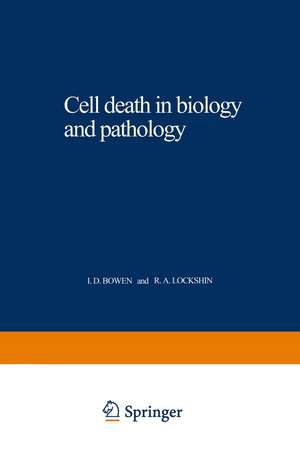Cell death in biology and pathology
Autor I. Bowenen Limba Engleză Paperback – 14 mar 2012
Preț: 399.12 lei
Nou
Puncte Express: 599
Preț estimativ în valută:
76.37€ • 80.16$ • 63.39£
76.37€ • 80.16$ • 63.39£
Carte tipărită la comandă
Livrare economică 11-25 aprilie
Preluare comenzi: 021 569.72.76
Specificații
ISBN-13: 9789401169233
ISBN-10: 9401169233
Pagini: 512
Ilustrații: XVIII, 493 p.
Dimensiuni: 152 x 229 x 27 mm
Greutate: 0.68 kg
Ediția:Softcover reprint of the original 1st ed. 1981
Editura: SPRINGER NETHERLANDS
Colecția Springer
Locul publicării:Dordrecht, Netherlands
ISBN-10: 9401169233
Pagini: 512
Ilustrații: XVIII, 493 p.
Dimensiuni: 152 x 229 x 27 mm
Greutate: 0.68 kg
Ediția:Softcover reprint of the original 1st ed. 1981
Editura: SPRINGER NETHERLANDS
Colecția Springer
Locul publicării:Dordrecht, Netherlands
Public țintă
ResearchCuprins
1 Cell death: a new classification separating apoptosis from necrosis.- 1.1 Introduction.- 1.2 Necrosis.- 1.3 Apoptosis.- 1.4 Validity of the classification.- 1.5 Summary and conclusions.- References.- 2 Cell death in embryogenesis.- 2.1 Introduction.- 2.2 Limb development and cell death.- 2.3 Development of the nervous system.- 2.4 Differentiation of the reproductive system.- 2.5 Epithelial cell death during fusion of the secondary palate in mammalian development.- 2.6 Lysosomes and the control of embryonic cell death at the cellular level.- References.- 3 Cell death in metamorphosis Richard.- 3.1 Introduction.- 3.2 Amphibian metamorphosis.- 3.3 Metamorphosis in invertebrates.- 3.4 A model of cell death in metamorphosis.- 3.5 Cell death in metamorphosis: the future.- References.- 4 Tissue homeostasis and cell death.- 4.1 Introduction.- 4.2 Growth patterns.- 4.3 Organ growth control.- 4.4 Model systems — the thymus.- 4.5 Homeostasis in malignant tissue.- 5 Cell senescence and death in plants.- 5.1 Introduction.- 5.2 Examination of senescent and dying cells.- 5.3 Biochemical and cytochemical consideration.- 5.4 Possibile interpretations of the biochemical, cytochemical and ultrastructural studies.- 5.5 Mechanisms of cell senescence and death revisited.- 6 The tissue kinetics of cell loss.- 6.1 Introduction.- 6.2 The cell cycle.- 6.3 The organization of cell populations.- 6.4 The measurement of the kinetics of cell loss.- 6.5 Some examples involving the measurement of cell loss kinetics in normal tissues.- 6.6 The kinetics of cell loss in tumours.- 6.7 Tissue responses.- 6.8 Conclusions.- References.- 7 Cell death and the disease process. The role of calcium.- 7.1 Introduction.- 7.2 Stages of cell injury 209 7.2.1 Comments on the stages.- 7.3 Mechanisms of progression.-7.4 The role of ion shifts in cell injury.- 7.5 Calcium and cell injury.- 7.6 Hypothesis.- 7.7 Summary 234 References.- 8 Cell death in vitro.- 8.1 Introduction.- 8.2 Cell aging and death in vitro.- 8.3 Donor age versus cell doubling potential.- 8.4 Species lifespan versus cell doubling potential.- 8.5 The finite lifetime of normal cells transplanted in vivo.- 8.6 Population doublings in vivo.- 8.7 Organ clocks.- 8.8 Clonal variation.- 8.9 Irradiation, DNA repair and effects of visible light.- 8.10 Cytogenetic studies.- 8.11 Error accumulation.- 8.12 The proliferating pool.- 8.13 Efforts to increase population doubling potential.- 8.14 Phase III in cultured mouse fibroblasts.- 8.15 Phase III theories.- 8.16 Can cell death be normal?.- 8.17 Dividing, slowly dividing and non-dividing cells.- 8.18 Aging or differentiation?.- 8.19 Functional and biochemical changes that occur in cultured normal human cells.- 8.20 Immortal cells.- References.- 9 Nucleic acids in cell death.- 9.1 The basic problem.- 9.2 Protein synthesis in eukaryotic cells.- 9.3 Nucleic acids in silk glands.- 9.4 Limitations of present data.- 9.5 Future developments 290 References.- 10 Mechanism(s) of action of nerve growth factor in intact and lethally injured sympathetic nerve cell in neonatal rodents.- 10.1 Introduction.- 10.2 Historical survey.- 10.3 The salivary NGF: morphological and biochemical effects induced in its target cells.- 10.4 Dual access and mechanisms of action of NGF in its target cells.- 10.5 Destruction of immature sympathetic nerve cells by immunochemical, pharmacological and surgical procedures.- 10.6 Surgical axotomy.- 10.7 Protective effects of NGF against 6-OHDA, guanethidine, vinblastine, AS-NGF and surgical axotomy.- 10.8 Some considerations and concluding remarks.- References.-11 Glucocorticoid-induced lymphocyte death.- 11.1 Introduction.- 11.2 Glucocorticoid receptors and metabolic effects in lymphocytes.- 11.3 Lethal effects of glucocorticoids on lymphocytes.- 11.4 Genetic analysis of glucocorticoid-induced cell death.- 11.5 Mechanisms of glucocorticoid-induced cell death.- 11.6 Conclusions.- References.- 12 The role of the LT system in cell destruction in vitro.- 12.1 Introduction.- 12.2 Molecular characteristics of the LT systems of cytotoxic effector molecules.- 12.3 Cellular processes involved in LT release by unstimulated (primary) and stimulated (secondary) human lymphocytes.- 12.4 Types of lytic reactions induced by lytic molecules of various weights in vitro.- 12.5 Conclusions.- References.- 13 Techniques for demonstrating cell death.- 13.1 Introduction.- 13.2 Microscopical.- 13.3 Cytochemical and biochemical.- References.- Author index.



